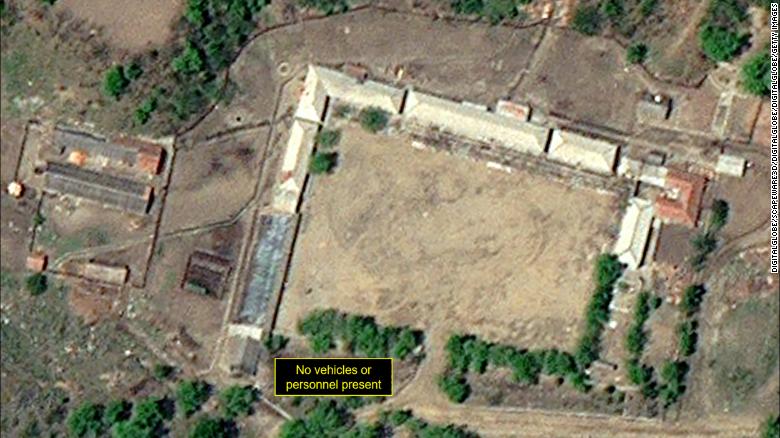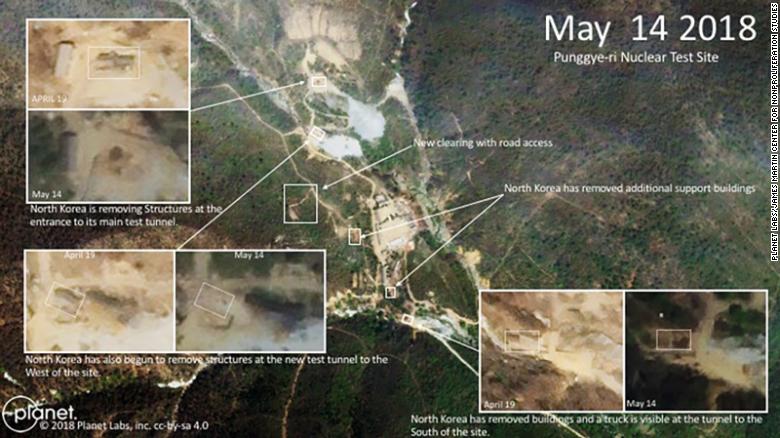 North Korea monitors claim nuclear test site dismantling has begun
North Korea monitors claim nuclear test site dismantling has begun
Satellite images from DigitalGlobe and 38 North on May 7 show support buildings at the Main Administrative Area have been taken down at North Korea's Punggye-ri nuclear test site.
(CNN)Satellite images appear to show North Korea is shuttering its nuclear test site, according to analysts from North Korean monitoring site 38 North.
Analysis published Monday claims photographs taken May 7 show some of the buildings at the site have been razed. Some rails for the mining carts, which are needed to dig tunnels, have also been removed, the 38 North piece claims.
Some key facilities remain intact and the tunnel entrances remain open, however. The authors speculate that may be because they'll be blown up in front of members of the international media later this month.
North Korea's Foreign Ministry announced over the weekend it would invite journalists to watch the site's shuttering as early as May 23.
The 38 North analysis was written by a former International Atomic Energy Agency nuclear chief inspector and long-time North Korea defense analyst.
Analysts at the James Martin Center for Nonproliferation Studies (CNS) shared with CNN satellite images that appear to show the North Koreans taking down facilities at Punggye-ri.
If accurate, the analysis of the images appears to show that North Korea has taken concrete steps to dismantle the Punggye-ri nuclear test site. The country's leader, Kim Jong Un, pledged last month to refrain from conducting nuclear tests and close Punggye-ri, which is located fewer than 100 miles from North Korea's border with China.
The country also vowed to stop testing missiles without notifying the international community Saturday.
The move is another notable step in North Korea's diplomatic charm offensive, which comes after a year of constant weapons testing and heated rhetoric between Washington and Pyongyang.
Kim met South Korean President Moon Jae-in at the heavily militarized border that divides the two Koreas in late April and will hold a summit with US President Donald Trump in Singapore in June, the first ever meeting between a sitting US president and North Korean leader.
South Korea's Defense Ministry said it is monitoring the developments at Punggye-ri closely, deputy spokesman Lee Jin-woo said at a news conference.
"North Korea has announced the dismantling of the Punggye-ri nuclear test site, so we assess that they will do preparatory work according to the planned schedule," he said.
In their findings published Friday, the analysts at CNS speculated that Pyongyang may be trying to remove sensitive information form the site. In the same piece, the authors also reported the construction of a new structure at the end of April, but at a different site that has been involved in the production or modification of launchers for its long-range ballistic missiles.
Some in the international community believe Kim's commitment to close Punggye-ri is a welcome development. Last month, President Trump called the North's decision to suspend missile and nuclear tests "very good news."
But it's also possible North Korea no longer needs the site. After a half dozens tests over a period of more than a decade, some experts believe that Pyongyang is far enough along in its nuclear weapons development that it no longer has to detonate bombs underground to move its program along.
Others have speculated that the tests have significantly damaged the underground facility. Chinese geologists claimed in a study the cavity caused by last September's nuclear test collapsed shortly after the detonation, causing a powerful tremor.
That test was the country's most powerful to date, believed to be more than ten times more powerful than its test the previous year.
However, analysts say the last five nuclear tests were all conducted using the same tunnel, and that although that tunnel may be damaged beyond repair, the North Koreans could dig others for potential future tests.
38 North observed late last year what it described as "significant tunneling operations" at a portal that has yet to be used.


No comments:
Post a Comment